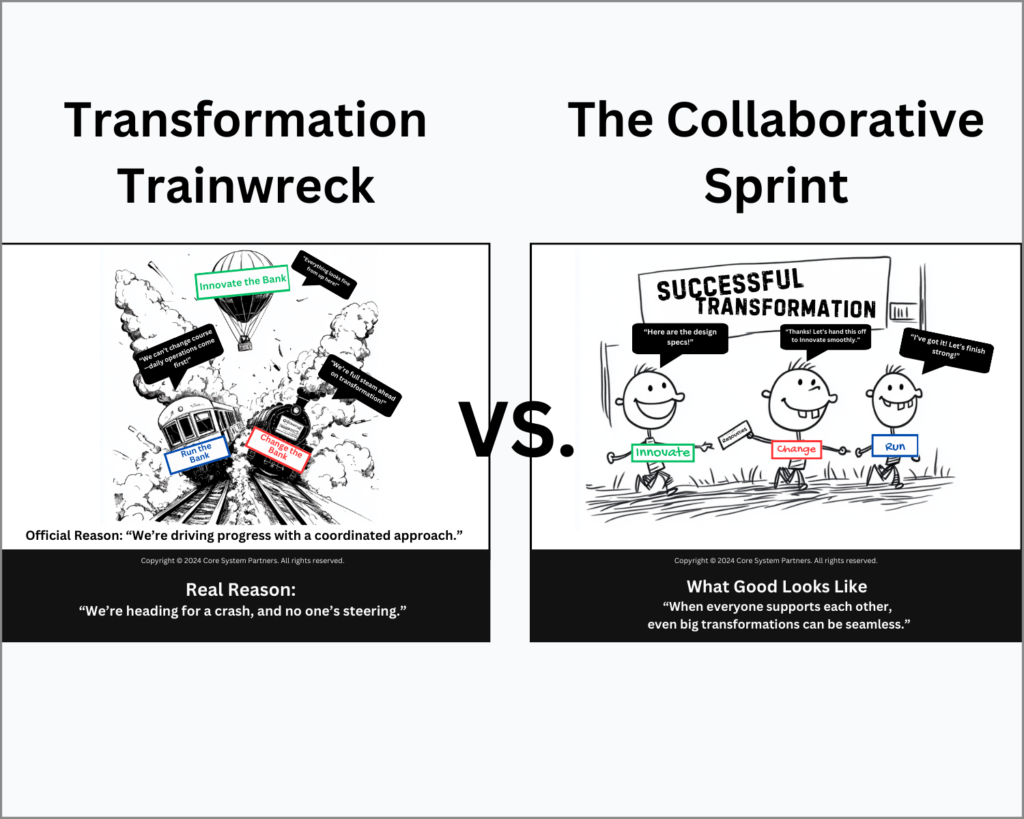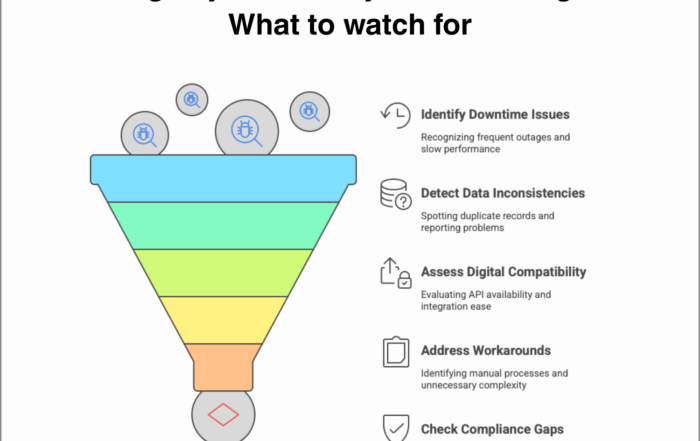Vol 3 #7

Embracing the Collaborative Relay: Transforming core banking operations from chaotic silos to a unified team effort, ensuring seamless integration of daily tasks, transformative changes, and innovative breakthroughs.
In core banking, the journey from daily operations to transformative change can sometimes feel more like a collision course than a strategic process. Imagine a bank where each department—operations, transformation, and innovation—acts independently, pushing forward with little regard for the other’s goals. The result? A chaotic, fragmented approach to progress. This disjointed style is hilariously captured in our cartoon “Transformation Trainwreck”, where the “Run the Bank” train and “Change the Bank” engine are heading towards each other, while an innovation hot air balloon floats somewhat detached, illustrating a lack of coordination that leaves teams—and outcomes—at risk.
Now contrast this with “The Collaborative Sprint”. Here, the same teams engage in a relay race, passing the baton seamlessly and supporting each other’s efforts. Each team—Run, Change, and Innovate—plays its part, contributing to a collective goal of successful transformation. This shift from chaos to collaboration shows the potential of coordinated teamwork to create efficient, impactful change. Let’s explore how banks can move from uncoordinated chaos to a collaborative relay where every team’s efforts are aligned and amplified.
The Chaos of Uncoordinated Efforts
“Transformation Trainwreck” vividly captures what happens when departments operate in silos. The Run the Bank team is focused on maintaining stability and efficiency in daily operations, while the Change the Bank team barrels forward with plans that may disrupt those very processes. Meanwhile, the Innovate the Bank team floats above, pushing for futuristic ideas that may seem detached from immediate needs.
Why Uncoordinated Efforts Happen
- Siloed Objectives: Each department has its own priorities and goals, often without a clear understanding of how their efforts impact other teams.
- Competing Timelines: Operations thrive on stability, while transformation and innovation require change—often at different paces.
- Resource Conflicts: When departments compete for budgets and resources, they may undermine each other’s initiatives, leading to conflict and inefficiency.
I’ve seen firsthand how this uncoordinated approach can lead to project delays, frustrated teams, and missed opportunities. Each department may be making progress in its own way, but without a shared direction, the overall outcome is compromised. The result? A metaphorical “trainwreck” that leaves everyone scrambling to pick up the pieces.
The Collaborative Relay: A Model for Coordinated Success
In “The Collaborative Sprint”, teams move from isolated efforts to a coordinated, supportive relay race. Each department has a specific role in achieving the bank’s transformation goals, and they work together to reach the finish line. The Run team keeps the bank’s day-to-day operations running smoothly, the Change team introduces new processes, and the Innovate team brings forward-thinking ideas that drive growth. The baton passes effortlessly, and the result is a seamless, strategic transformation.
Key Elements of a Collaborative Relay
- Clear Roles and Responsibilities: Each team understands its function within the larger strategy, minimizing overlap and fostering respect for each other’s contributions.
- Aligned Timelines: The teams work within a coordinated timeline, ensuring that changes are introduced in a way that complements daily operations and innovation efforts.
- Resource Sharing: Rather than competing for resources, teams share and allocate budgets, talent, and tools in a way that supports their combined mission.
In a relay, each runner has a specific distance to cover, and they trust their teammates to play their part. Similarly, when banking teams adopt this collaborative relay model, they’re not only running their own race but also working in unison toward a shared goal.
Moving from Chaos to Collaboration: Steps to Implement a Coordinated Approach
Shifting from a chaotic environment to a collaborative relay takes effort and commitment. Here are some practical steps that can help core banking teams coordinate effectively and support each other’s roles:
1. Establish a Unified Vision
Create a shared vision that aligns with the bank’s mission and objectives. This vision should clarify how operations, transformation, and innovation contribute to the bank’s success. When every team understands the overall goal, they’re more likely to support each other’s efforts.
- Example: Develop a mission statement that emphasizes the importance of both stability and growth, making it clear that each department’s role is vital.
2. Define Interconnected Goals
Set goals that require contributions from multiple departments. This interconnected approach ensures that each team’s efforts are part of a cohesive strategy, encouraging collaboration instead of competition.
- Example: Create a goal around improving customer experience that involves Operations optimizing current processes, Transformation introducing new systems, and Innovation exploring AI tools.
3. Implement a Cross-Functional Calendar
Use a shared calendar that shows project timelines, deadlines, and milestones for each department. This cross-functional view allows everyone to see how changes will impact daily operations and vice versa.
- Example: Set up a digital project management tool that lets teams track their progress, mark deadlines, and view each other’s schedules. This transparency reduces scheduling conflicts and encourages proactive adjustments.
4. Conduct Regular Alignment Meetings
Hold regular check-ins where each team updates others on their progress, challenges, and upcoming tasks. These meetings foster communication, help prevent misunderstandings, and allow for adjustments that keep all departments aligned.
- Example: Schedule a monthly “relay review” meeting where each team presents its progress and future plans. Encourage questions and input from other departments to maintain alignment.
5. Celebrate Collective Wins
Recognize achievements that result from collaborative efforts. Celebrating these collective wins reinforces the importance of teamwork and shows each department that their role is valued within the bigger picture.
- Example: When a project reaches a milestone, host a small celebration or send a team-wide message acknowledging the contributions of each department. This encourages ongoing collaboration and reinforces a sense of shared purpose.
Benefits of a Coordinated, Collaborative Approach
Adopting a collaborative relay model doesn’t just streamline processes; it transforms the work culture. When each team respects the other’s role and works together toward common goals, the bank becomes more agile, resilient, and able to navigate change with ease.
Improved Efficiency
With clear roles and aligned timelines, there’s less overlap and fewer conflicts. Teams can work on their projects without unnecessary delays, knowing that they’re contributing to a coordinated effort.
Enhanced Morale and Engagement
When teams feel their contributions are valued, morale improves. A collaborative culture also makes work more engaging, as employees see how their efforts impact the bank’s success.
Greater Adaptability
A relay model enables the bank to adapt more effectively to changes in the market. With every team moving in the same direction, new initiatives can be introduced without disrupting daily operations or creating internal friction.
Embracing the Collaborative Relay for Lasting Success
In core banking, where every department plays a crucial role in the bank’s mission, collaboration is key. As “The Collaborative Sprint” shows us, when teams work together as part of a coordinated relay, they create a seamless journey from daily operations to transformative growth. By aligning goals, sharing resources, and respecting each other’s contributions, banks can transform from a “Transformation Trainwreck” to a streamlined, strategic powerhouse.
The next time you’re in a meeting, ask yourself: Are we working as a relay team or heading toward a collision? By embracing a collaborative relay model, we can shift from uncoordinated chaos to cohesive success, making every step in the banking transformation journey count.
#CoreBankingTransformation #RunChangeInnovateTheBank




